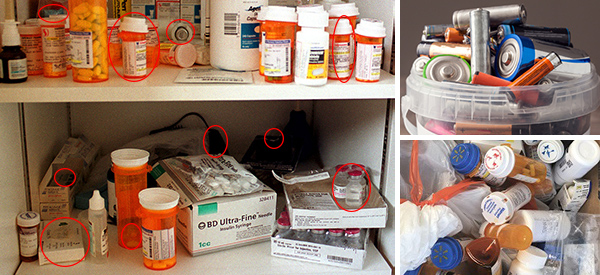Medicine cabinets are interesting things. While useful for the storage of medicines and other things that we need, many seem to turn into a black hole. Anything that enters into the gravitational pull of a medicine cabinet is there forever. You never see it leave. That can be good when you need something, but it can also be very bad for you and your family.
The basic problem is that many of the things we use won’t last forever. While the expiration dates on many products are a bit arbitrary and most medicines will be good far beyond that date, the fact of the matter is that we don’t really know how long they will last. Worse than that, there are things we store in our medicine cabinets which can actually go bad over time and could cause an infection, if we were to use them.
To combat this, we really should clean out our medicine cabinets from time to time. Some people say that we should do so twice a year, when we change our clocks. If you can’t do that, then at least make it part of your spring cleaning; so that you know that anything in there is at least reasonably sure of still being useful.
So, what sort of things do we really want to get out of our medicine cabinets? For that matter, what sort of things should we avoid storing in there all together?
Unidentifiable or Unknown Medicines
It seems just about everyone keeps old medicines around, especially prescription medicines. We pay so much for them, that we hate to let them go, even when we’re not using them anymore. Apparently there’s a universal attitude that we might need them someday.

But old medicines can be dangerous, especially if they have lost potency.
While we can be fairly confident that any prescription medicine will outlast its “use by” date, we don’t know by how much. A year or two is probably fine, but anything longer could be dangerous.
That’s not the biggest problem though; the big problem is medicines that we can’t identify. Sometimes the labels get smeared or torn. Others may still have the labels on them, but we have no idea what they do. In either case, if you’re not sure of what it is or what it does, you shouldn’t be keeping it around. Better to dispose of it, rather than take a chance of misusing it.
Related: Top 6 Most Dangerous Medicines for People over 40. Are You Taking Any of These?
Old Cosmetics
We don’t normally think of cosmetics going bad, but they can. The problem is, when they do go bad, they can be the cause of infections. So we want to be sure that any cosmetics we are using, especially eye makeup, are safe. Otherwise, they could cause an infection.
There are four signs that cosmetics are going bad or have gone bad. These include severe changes in color, odor and consistency. In addition, some cosmetics will grow black or grey fungi on the surface. These should all be thrown away immediately.
Discolored Products
Cosmetics aren’t the only thing that can become discolored over time. Many other products can as well. That usually happens because of a chemical change in the product.
The problem is, we don’t know what sort of chemical change has happened. So, just to be on the safe side, you should probably get rid of them.
Acne Products
Of all the things in our medicine cabinets, probably the one which goes bad the fastest is products for treating acne. Any of these which contain benzoyl peroxide and salicylic acid will only last for about six months.
After that, these chemicals tend to lose their potency, even in a closed container. So they won’t do what they’re supposed to do.
Expired Sunscreen
 One of the things in our medicine cabinets which has an expiration date that really means something is sunscreen. FDA regulations require that sunscreens retain their potency for a minimum of three years after the expiration date.
One of the things in our medicine cabinets which has an expiration date that really means something is sunscreen. FDA regulations require that sunscreens retain their potency for a minimum of three years after the expiration date.
That’s good news, but it also hides some bad news. That is, after the three years, you can’t count on it. Better to get rid of it, than have it not work when you need it to.
Old Rubbing Alcohol & Hydrogen Peroxide
Believe it or not, both hydrogen peroxide and rubbing alcohol can lose their potency over time. When they do, they’re about as useful as water. In fact, that’s mostly what they are. These aren’t pure products, as sold in the pharmacy, they’re mixed with purified water. As the alcohol and hydrogen peroxide evaporate off, the concentration in the bottle becomes less and less.
Fortunately, these two disinfectants are inexpensive to buy. So there’s really no problem in buying a new bottle and throwing away the old one, even if you do it every few months. But you don’t have to do it that often; they will last at least a few years, if the bottles are closed tightly.
Related: 36 Survival Uses For Hydrogen Peroxide
Contact Lens Cases You’re Not Using
Contact lens cases can easily become a breeding ground for bacteria. Your fingertips have millions of bacteria on them. So, when you get the contact out, you can be putting bacteria in. Left sitting in your medicine cabinet, that contact lens case can be like a petri dish, growing invisible bacteria.
According to the American Academy of Ophthalmology, you should replace your contact lens case every three months. When you do, be sure to throw the old one away and don’t just stash it in your medicine cabinet.
Expired Contact Lens Solution
Contact lens solution is another medicinal product which has an expiration date that really means something. In fact, you should never use it, once it has passed that date, even if the bottle is full.
It is just too easy for contact lens solution to become contaminated, which would cause you to be putting bacteria onto the lens and then into your eye, rather than cleaning any bacteria off of the lens.
Old Petroleum Jelly
 Petroleum jelly isn’t anti-bacterial in any means, unless it has had something added to it to make it antibacterial. That means that every time you stick your finger in the container, you’re introducing bacteria into it.
Petroleum jelly isn’t anti-bacterial in any means, unless it has had something added to it to make it antibacterial. That means that every time you stick your finger in the container, you’re introducing bacteria into it.
While there is nothing in petroleum jelly to feed the bacteria, they will live for some time.
If you’re like a lot of people and buy the giant size containers of petroleum jelly, that gives more time for bacteria to accumulate in it. Buying smaller containers eliminates this problem. Those large containers which have been sitting around for the last century or so should probably be removed and replaced.
While the old petroleum jelly might not be ideal for use in medicinal purposes, you might want to hold onto it anyway. Use it to make tinder for fires, by working it into cotton balls at a ratio of about a teaspoon per cotton ball. It will ignite easily and burn hot for about three minutes, helping you to get fires started in damp conditions. Just be sure to keep them in an airtight container, like a petroleum jelly jar.
Related: 10 Reasons Why You Need to Have Petroleum Jelly in Your Stockpile
Bandages and Feminine Hygiene Products with Damaged Packages
Tampons, sanitary napkins and sterile bandages all have some things in common. First of all, they are all sterilized before leaving the factory. Secondly, they are all individually packed in thin paper packages, which are designed to keep them sterile. But if the package becomes damaged in any way, all bets are off. You can be fairly sure that it is no longer sterile.
Considering the use of these items, it’s too risky to use them, once the package has been broken open. The chances of infection are just too high. It’s best to throw them away and get new ones.
Be sure to check the bandages in your family first-aid kit too. Even though they are contained within the kit, there’s no guarantee that the paper package won’t become damaged. If it is, it’s time to replace it.
Anything in Damaged Packaging
While it is critical to get rid of bandages and feminine hygiene products in damaged packaging, you should probably extend that a bit farther, throwing away anything in packages that no longer close.
Not only does that open lid offer easy access for bacteria, it also allows the contents to spill or evaporate. Those spills can damage other useful products.
Razors
While razors don’t expire, they can rust. Unlike most cutlery today, razors are not made from stainless steel. Rather, they are made from what is known as “high carbon steel”. As such, they can rust. Keeping them in your medicine cabinet, where moisture can become trapped, is a good way of allowing them to rust, before you can use them.
You’re better off keeping those razor blades out in the open, even with the humidity in the average bathroom, than you are in keeping them in the medicine cabinet. The humidity in the bathroom dissipates, but it doesn’t from a closed cabinet.
If you’re going to keep your spare razor blades in the medicine cabinet, or even in the cabinet under the sink, it’s best to put them in plastic zipper bags or food storage containers. Either of these will provide an airtight environment, which is protected from moisture.
Related: 9 Natural Remedies To Heal Wounds Faster
Dead Batteries
 So many small medical devices, such as digital thermometers and blood pressure cuffs, require batteries.
So many small medical devices, such as digital thermometers and blood pressure cuffs, require batteries.
We either buy them with the batteries already installed, or put them in when we buy the product and then forget about it. But we shouldn’t. We need to make sure those batteries stay good, as bad batteries will damage the devices they are stored in.
The humidity that exists in most medicine cabinets won’t just cause razor blades to rust, but also any other metal devices. The combination of that humidity and the presence of an electrical charge can speed up the corrosion process, destroying your devices. Regular checks of the batteries will help you see if anything is happening to the battery contacts as well.
If you do see some corrosion starting to form on the contacts, the easiest way to clean it off is with a pencil eraser. That only works with small amounts of corrosion though. If your contacts are badly corroded, you’ll need a brass wire brush.
Non-functional Medical Devices
Part of checking those batteries is making sure the devices they are in still function. If they don’t, check the batteries first. Then look for corrosion. If you can’t get the device working, throw it away and buy another one. Leaving a non-working device in your medical cabinet will just make you think you’re okay, because you have it. Throwing it away will set the impetus to buy another.
Taking old things out of your medicine cabinet is fine, but you need to make sure you replace them, especially those that you use regularly. As with many other things that we preppers stockpile, a good stockpile of basic medical necessities is an essential to survival. So add the replacements to your shopping list and make sure you pick them up. Don’t wait!
You may also like:
 The Only 4 Antibiotics You’ll Need when SHTF
The Only 4 Antibiotics You’ll Need when SHTF
The U.S. Army’s Forgotten Food Miracle (Video)
How to Make Vicks Vapor Shower Tablets to Treat Your Flu this Winter















While I cannot tell you how long different meds have full potency, I can tell you that a friend worked in a pharmaceutical plant in Charlotte NC and said that some of the drums they used to make human meds on day shift, and pet meds on night shift had dates on them showing they were over 20 years old.
I can’t say what went on in that individual company, but for the 7-8 Pharmaceutical companies (one neutracutical, one cosmetic aerosol company) as R&D Research chemist, Lab supervisor, R&D/QC Lab Manager for a total of more than 25 years: I never saw any over aged storage of any substance for use as final drug product (don’t go into the R&D organic storage room). Think, if you had to pay mortgage for a house for 20 years and no one lived there. Doesn’t make sense. Businesses need to buy the raw materials, process, then distribute to make money. Pharmaceutical companies “GENERALLY” make a well tested products, put it up on stability testing for 5 years (under numerous rugged conditions), and give the proof of stability data for 5 years for EACH product to the FDA for approval of 2 years to consumers. Some products with less stability are approved for less than 2 years of shelf life. As a Chemist, I realize that many individual compounds last 1000’s of years (i.e. oil, minerals, Gold, …) without any degradation.
Expired sun block cream makes a great shave cream, as does hair conditioner that you may no longer use..
I wouldn’t throw out those sterile bandages that become unsterile, unless the bandages become wet. You can still use it, as long as you don’t apply directly to the wound, but can use to pad or to absorb fluids.
Good way to save your razors’ edges–get a glass or plastic custard cup or some small container; drop in razor; fill with cooking oil, enough to cover blades of razor; after each shave, shake water off razor and store it in this “oil bath.” Ain’t gonna rust for days or weeks!
I get 10 razors for a buck at the Dollar Stores and they last me quite a long time when they’re not being used and stored in my “oil bath.” Plus, when you first use the razor, the cooking oil really makes the razor glide!
On another prepper page I read about a good idea for storing razors. Keep the silica gel packs that come with shoes, purses, etc. You can store your new razors in a zip lock with the silica pack to keep them drier. And you can open the packs, empty the silica in a jar and put your razor into the silica to dry it out fast and keep it from rusting.
Chemicals degrade in time.
Even unbroken packages will become less effective, in time.
Most razor blades used for shaving are some sort of stainless steel.
Keeping any metal in a humid environment is just asking for oxidation more commonly known as rust.
I keep the stainless blades in a room other than the bathroom. I keep my carbon steel blades in a sealed canning jar, with an oxigen pack. Just like storing dehydrated food stuffs.
This seems to work.
tp
My medicine cabinet: gold color Listerine (great for preventing plaque and a decent topical anti biotic), Q tips, Extra strength Excedrin and Pepto bismol tablets (migraine kit), Motrin ( daily pain from operating shovel), standardized Echinacea (one cap every 3-4 days prevents 100% of colds and flu), Salmon Oil (great all around anti-inflammatory), various supplements, Roselle, fresh garlic w/lime juice, cheap white Tequila, 4% Lidocaine Cream, medicinal pot and Billberry extract for Sweety’s glaucoma (plus an RX for that), world’s best hypoallergenic moisturizer, Dream Creme by Lush. I don’t go to Western style Drs except to get sewed up and I am never sick. Life is good, Medicare is making money off me.
Just think how healthy this country would be if everyone followed your protocol!
If you are injured, get to an emergency room – they can fix you. If you have a chronic condition, stay away from western trained doctors – they have no clue how to fix you.
IvyMike–if the Listerine has sodium benzene or proplyene glcol in it, stop using it. See the book, The Cure For All Cancers’–Dr. Hulda Clark. Those are the 2 worst ingredients to have in anything. Parasites in your body feed off those 2 chemicals like crazy, setting the stage for problems down the line. I am holistic/homeopathic, and haven’t been to a medical doctor in years. Dentist only, and even that I have to tell him what he can use on me and what not to use. Also, be careful with the Pepto. Get your gut bacteria in good shape and you probably won’t need it.
What do you use the Tequila for?
Don’t throw away tampons in slightly damaged packaging.
As long as they are dry they make a great tinder for starting a fire and don’t need to be sterile.
Same goes for bandages and petroleum jelly.
Liquid oils can also be used with a wig for light or coocking.
Beside this, empty and clean the containers of the old medicine and use them for survival items or workshop (screws etc.) 🙂
Non-sterile bandages are fine when used on non-damaged skin. In my family we do not throw bandages (especially elastic ones) after use – instead we wash them, let them dry and store for future use. We did this multiple times without problems.
One more note about gauze dressing. It can also be used on non-damages skin even when package was damaged or opened, assuming that it was kept in a dry place and still looks good (no stains, etc.)